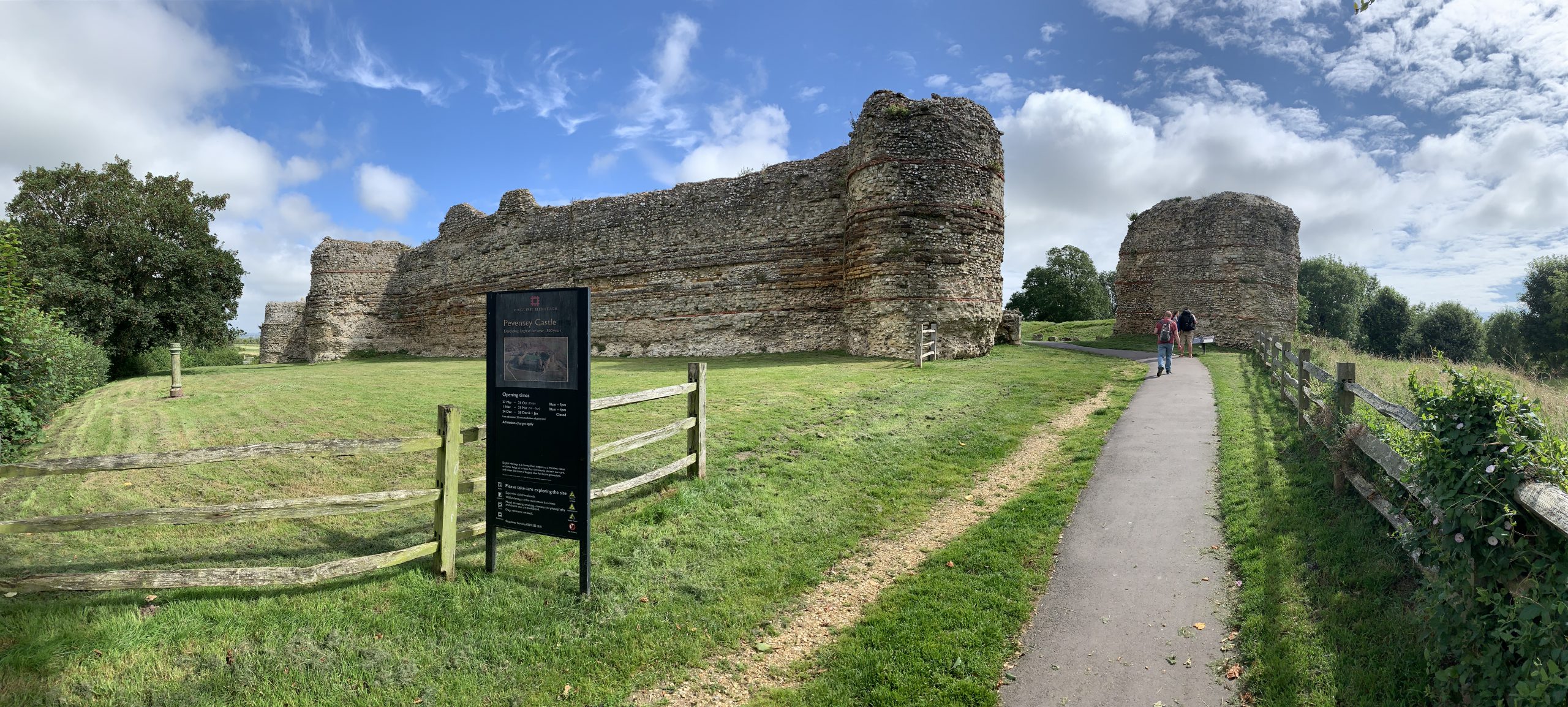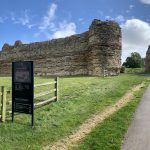The Romans established a significant presence in Southeast England in the first century AD. They began their conquest of Britain in 43 AD, under the leadership of Emperor Claudius. The region of Southeast England, including modern-day Kent, East and West Sussex, Hampshire, Berkshire and London, became a key area of Roman settlement and expansion which is evidenced by numerous archaeological sites, including the remains of villas, roads, and military forts.
Richborough (Rutupiae) Roman Fort
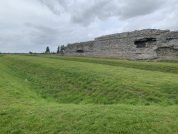
The Roman fort Rutupiae, now called Richborough Castle was the Gateway to Britain, long before Dover. It is here that the 4 invading Legions under Aulus Plautius assembled after landing in Britain during the Claudian Invasion of A.D. 43.
It is part of a larger Roman town called Rutupiae or Portus Ritupis that developed around the fort and the associated port. The settlement was founded after Roman conquest of Britain of Britain in AD 43. Because of its position near to a large natural harbour in the Wantsum Channel and to the mouth of the Stour, Rutupiae served as a main gateway to Roman Britain and the starting point for the road now known as Watling Street. The site is now two and half miles inland from the current coastline.
Earth fortifications were first dug on the site in the 1st century, probably for a storage depot and bridgehead for the Roman army. The site expanded into a major civilian and commercial town, and the stone Saxon Shore fort was added around the year 277. The later fort is believed to have been constructed by the rebel Carausius.
The site is now under the care of English Heritage.
Read more about the Richborough (Rutupiae) Roman FortFishbourne Roman Palace
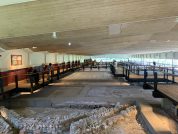
Fishbourne Roman Palace is a large Roman villa which was built in the 1st century AD and was one of the largest residential Roman structures ever discovered in Britain. The palace is believed to have been built for the Roman governor of Britain at the time, although its exact purpose and history is still not entirely clear. It is known that the palace was a luxurious residence with extensive gardens and decorative features, including intricate mosaic floors and wall paintings.
Some of the most significant discoveries at Fishbourne Roman Palace include a number of well-preserved mosaics, which provide a glimpse into the lives and interests of the people who lived in the palace. These include depictions of animals, mythological figures, and scenes from everyday life.
The palace also features a number of other interesting structures, including a large bathhouse, which would have been used for relaxation and exercise. The site has been carefully preserved and is now open to the public, with a museum and interpretive centre on site where visitors can learn more about the history of the palace and the Roman occupation of Britain.
Read more about the Fishbourne Roman Palace (Villa Regis Cogidubni)Lullingstone Roman Villa
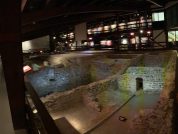
Lullingstone Roman Villa is a well-preserved Roman villa which dates back to the 1st century AD and was in use until the 5th century AD. The villa was a luxurious residence that was likely owned by a wealthy Roman family. It featured extensive gardens, decorative features, and a number of rooms for living and entertaining. Some of the most impressive features of the villa include a bathhouse, a hypocaust (underfloor heating system), and intricate mosaic floors.
One of the most interesting aspects of Lullingstone Roman Villa is its Christian connection. The villa is home to one of the earliest known Christian chapels in Britain, which was built in the 4th century AD. The chapel contains a number of well-preserved frescoes, including a depiction of the baptism of Christ. This discovery has led to Lullingstone being regarded as an important site for the history of Christianity in Britain.
The villa is now open to the public and managed by English Heritage.
Read more about the Lullingstone Roman VillaCanterbury (Durovernum Cantiacorum)
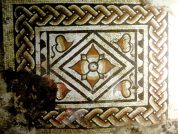
Canterbury’s origins can be traced back to the Iron Age when it was a settlement of the local Celtic tribe, the Cantiaci, in the 1st century AD. However, in 43 AD, the Romans invaded Britain and took control of the Celtic settlement, reconstructing it as a new town called Durovernum Cantiacorum. The Romans designed the new streets in a grid pattern and used stone to construct public buildings. At the heart of Roman Canterbury stood the Forum, a public space lined with shops, and the basilica, serving as the town hall. The Forum also acted as a marketplace, and there were temples and public baths where people could socialize in Roman times, much like going to a pub today. While the wealthy built stone houses with mosaic floors, the poor lived in huts made of wood and plaster. In the early 3rd century, a wall was constructed around Canterbury, which thrived for 300 years. However, in the 4th century, Roman civilization declined, and with it, the prosperity of Canterbury.
Today the best way to see Roman Canterbury is by visiting the Canterbury Roman Museum, followed by a walk around the city walls.
London (Londinium)
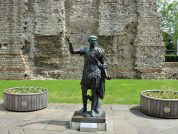
Roman Londinium (London) was an important settlement in Roman Britain that was founded around AD 50, shortly after the Roman conquest of Britain. The settlement was located on the banks of the River Thames, which provided access to the sea and allowed for easy transportation of goods and people. Initially, the settlement was a military fortress known as Londinium, built to control the Thames and protect Roman interests in the region. However, it quickly developed into a major trading centre, housing 45,000 and 60,000 people at its peak, with merchants from all over the Roman Empire bringing goods to the city to sell or trade.
The city was surrounded by walls and gates for protection and had many public buildings and amenities, including a forum, a basilica, a bathhouse, and a theatre. The city also had a temple to the god Mithras, which was one of the largest Mithraic temples in the Roman Empire.
Roman London was an important centre of trade and commerce, with goods such as pottery, glassware, and metalwork being produced in the city and exported to other parts of the Roman Empire. The city also had a busy port, which allowed for the importation of goods such as wine, olive oil, and grain.
Roman London declined in the 4th century AD, after the Roman Empire began to withdraw its troops from Britain. The city was largely abandoned and fell into disrepair until the Middle Ages, when it began to be rebuilt and eventually became the city of London that we know today.
Read more about the London (Londinium) Roman SettlementPevensey (Anderitum) Roman Fort
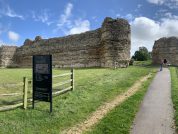
Pevensey Castle or Anderitum (also Anderida or Anderidos) was a Saxon Shore fort in the Roman province of Britannia. The ruins adjoin the west end of the village of Pevensey in East Sussex, England. The fort was built in the 290s and was abandoned after it was sacked in 471 (491 according to the disputed Anglo-Saxon Chronicles). It was re-inhabited by Saxons and in the 11th century the Normans built a castle within the east end of the fort.
The site is managed by English Heritage.
Read more about the Pevensey (Anderitum) Roman FortPortchester Castle (Portus Adurni)
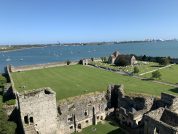
Portus Adurni was a Roman fort in the Roman province of Britannia situated at the north end of Portsmouth Harbour. It was part of the Saxon Shore, and is the best-preserved Roman fort north of the Alps.[1] Around an eighth of the fort has been excavated. It was later converted into a medieval castle known as Portchester Castle.
The site is managed by English Heritage.
Read more about the Portchester (Portus Adurni) Roman FortSilchester (Calleva Atrebatum) Roman Town
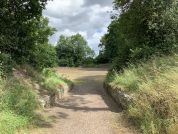
Silchester (Calleva Atrebatum) Roman Town is one of the best preserved Roman towns in Britain. It is one of the very few that has had continuous occupation since the Iron Age. The principal ruins are the third century town walls of which an impressive, almost entire circuit still exists. They front an earlier second century rampart with an outer ditch. You can also see the massive Iron Age outer defences alongside the car park. The amphitheatre is an important feature where you can visit the seating bank and the theatre. It is an evocative place where you can imagine the gladiators, wild beast fights and the public executions that used to happen here. You can also visit the medieval church of St Mary, the fabric of which is 12th century. Fragments of a Norman font show that the church dates from much earlier. There are also some well preserved fourteenth century wall paintings. Archaeological finds from the site can be seen in Reading Museum, including the magnificent Silchester eagle.
Read more about the Silchester (Calleva Attrebatum) Roman SettlementDover (Dubris)
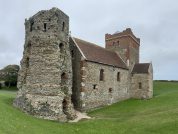
Roman Dover, the British port closest to the rest of the Roman Empire was a thriving town, thought to have covered at least a five hectare area along the Dour valley. The Romans called the town DUBRIS after DUBRAS, the British name meaning ‘waters’. The Romans built two successive forts btween AD 115 to the early third century, to protect the Classis Britannica. Another fort was built around AD270 as part of the Saxon Shore Forts. In addition to the fort, there are also other Roman remains in Dover, including a Roman lighthouse, which is in Dover Castle (run by English Heritage), which is the oldest surviving building in Britain, a Roman mansio known as the Roman Painted House, which was discovered in the 1970s during excavations for a car park and Dover Museum which stands on top of the Classis Britannica fort of which parts if the wall can be seen.
Read more about the Dover (Portus Dubris) Classis Britannica FortReculver (Regulbium)
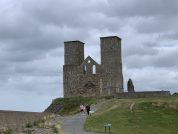
The fort at Reculver (Regulbium) was established by the Romans in the late 1st century AD, as part of their efforts to control the south-eastern coast of Britain. The fort was built from stone and had a rectangular layout, with walls that were up to 2 meters thick. It was likely garrisoned by a cohort of Roman soldiers, and served as a key defensive position for the region.
After the Romans left Britain in the 5th century AD, the fort was abandoned and fell into ruin. In the 7th century, a Saxon monastery was established on the site, which became an important centre of learning and culture in the region. The monastery was destroyed by Viking raiders in the 9th century, and the site was subsequently abandoned.
Today, the ruins of Regulbium can still be seen at Reculver. The remains of the Roman fort include sections of the outer walls, as well as the foundations of the main gatehouse and other buildings. The site is managed by English Heritage.
Read more about the Reculver (Regulbium) FortBignor Roman Villa
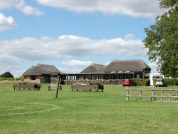
Bignor Roman Villa is an important archaeological site located in the village of Bignor, West Sussex, England. It is one of the largest and most well-preserved Roman villas in Britain, and it provides valuable insights into the daily life and culture of the Roman occupants. The villa was built in the 1st century AD and was occupied until the 4th century. It was discovered in 1811 by a farmer who was ploughing his fields, and since then, it has been extensively excavated and studied by archaeologists.
The villa consists of a series of buildings arranged around a courtyard, including a bathhouse, a granary, and several residential quarters. The most impressive feature of the villa is its elaborate mosaic floors, which are some of the finest examples of Roman mosaics in Britain. The mosaics at Bignor depict a range of subjects, including mythical scenes, animals, and geometric patterns. One of the most famous is the “Dionysus mosaic,” which depicts the god of wine surrounded by grapevines and animals. In addition to the mosaics, the villa also contains a number of other artefacts and features that provide insights into daily life during the Roman period. These include pottery, coins, and tools, as well as evidence of farming and animal husbandry.
Today, Bignor Roman Villa is open to the public and is managed by the Bignor Roman Villa Trust. Visitors can explore the site and its various features, including the mosaics and the bathhouse, and learn about the daily life and culture of the villa’s Roman occupants.
Read more about the Bignor Roman VillaChichester (Noviomagus Reginorum)
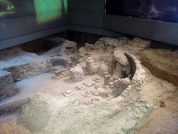
Noviomagus Reginorum Roman occupation of the Chichester site began with the construction of a military supply base, perhaps as early as the winter of 43/44AD and probably abandoned by the military in 47. The name Noviomagus Reginorum is a Latin phrase that means “new market of the Regni tribe,” which was the name of the local Celtic tribe. It quickly became an important centre of trade and commerce in the region. It was strategically located at the crossroads of several major Roman roads, which helped to facilitate trade and communication throughout the region.
The four main streets of the Roman layout are still visible today, and you can also visit the well-preserved remnants of the 3rd-century AD Roman walls, which were constructed to protect the city from coastal raiders. The magnificent 12th-century Cathedral, contains not only a collection of treasures but also the remains of a Roman mosaic. The Novium Museum, houses the remains of the Roman bath complex discovered at the end of the 20th century. The museum also boasts a recently refurbished Roman gallery, where visitors can marvel at a mosaic unearthed during the excavation of a suburban villa in Chilgrove. The Central Market Cross, a 15th-century structure, stands at the crossroads of the four principal streets of the city. Finally you can explore the remains of the amphitheatre, although it does just resemble a small depression in the ground.
Read more about the Chichester (Noviomagus Reginorum)Butser Ancient Farm
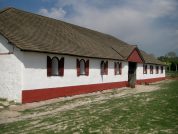
Located within the South Downs National Park, Butser Ancient Farm is a remarkable outdoor space that showcases Ancient Britain through experimental archaeology. The farm offers visitors the opportunity to explore reconstructed buildings from the Stone Age, Iron Age, Roman, and Anglo-Saxon periods, observe ancient breeds of animals, and try your hand at ancient skills!
The highlight here is visiting the reconstructed roman villa, of the second century aisled hall villa at Sparsholt.
Crofton Roman Villa
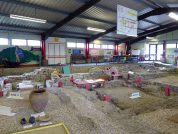
The Crofton Roman Villa house was occupied from about AD 140 to 400 and was the centre of a farming estate of about 500 acres. Nearby would have been farm buildings, surrounded by fields, meadows and woods.
The house was altered several times during its 260 years of occupation and at its largest probably had at least 20 rooms. The remains of ten rooms can be seen today, now within a modern cover building. Two rooms contain the remains of their opus signinum (concrete) floors, and three have evidence of tessellated (tiled) floors. Details of the under-floor central heating (hypocaust) can be seen, which features both channelled and pillared systems.
The site is open Tuesdays and Wednesdays 10-4.00pm. April to October.
Read more about the Crofton Roman VillaOther sites include Faversham (Durolevum) where you can see a temple beneath a Christian chapel. Walmer beach at Deal has a commemorative stone laid on ‘The Strand’ (promenade). The inscription on the plinth simply says, “The first Roman Invasion of Britain led by Julius Caesar landed near here LVBC.” Winchester City Museum has a number of mosaics and Roman artefacts.
